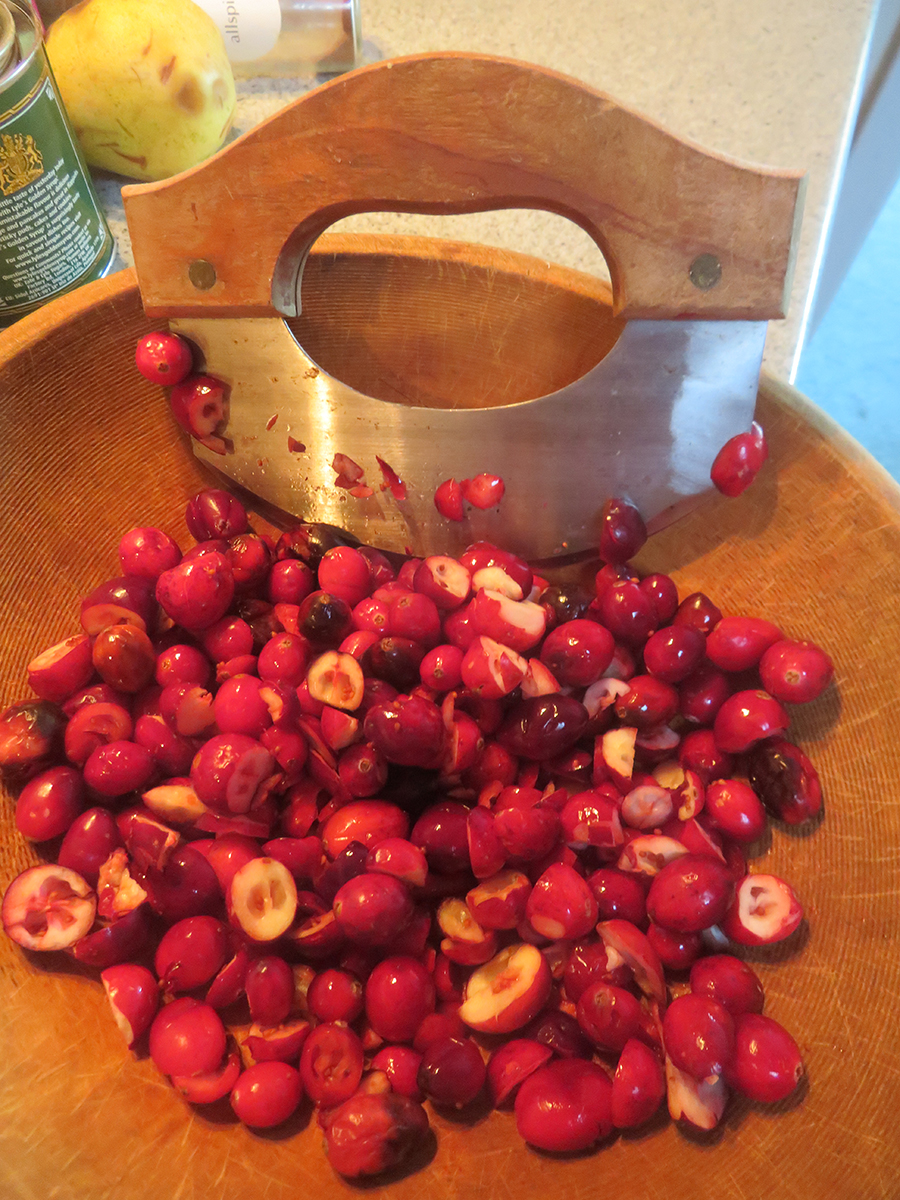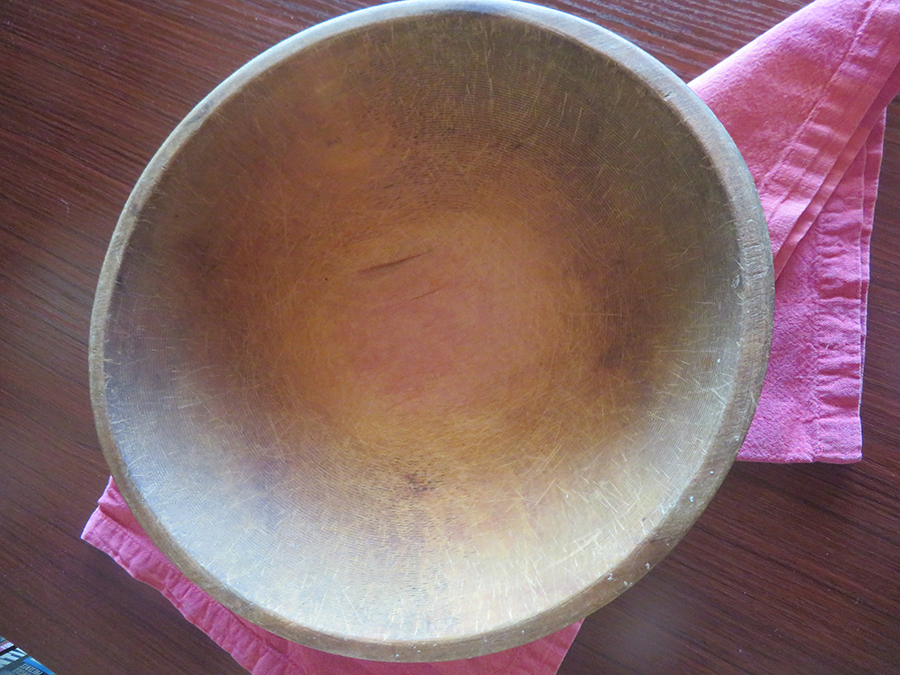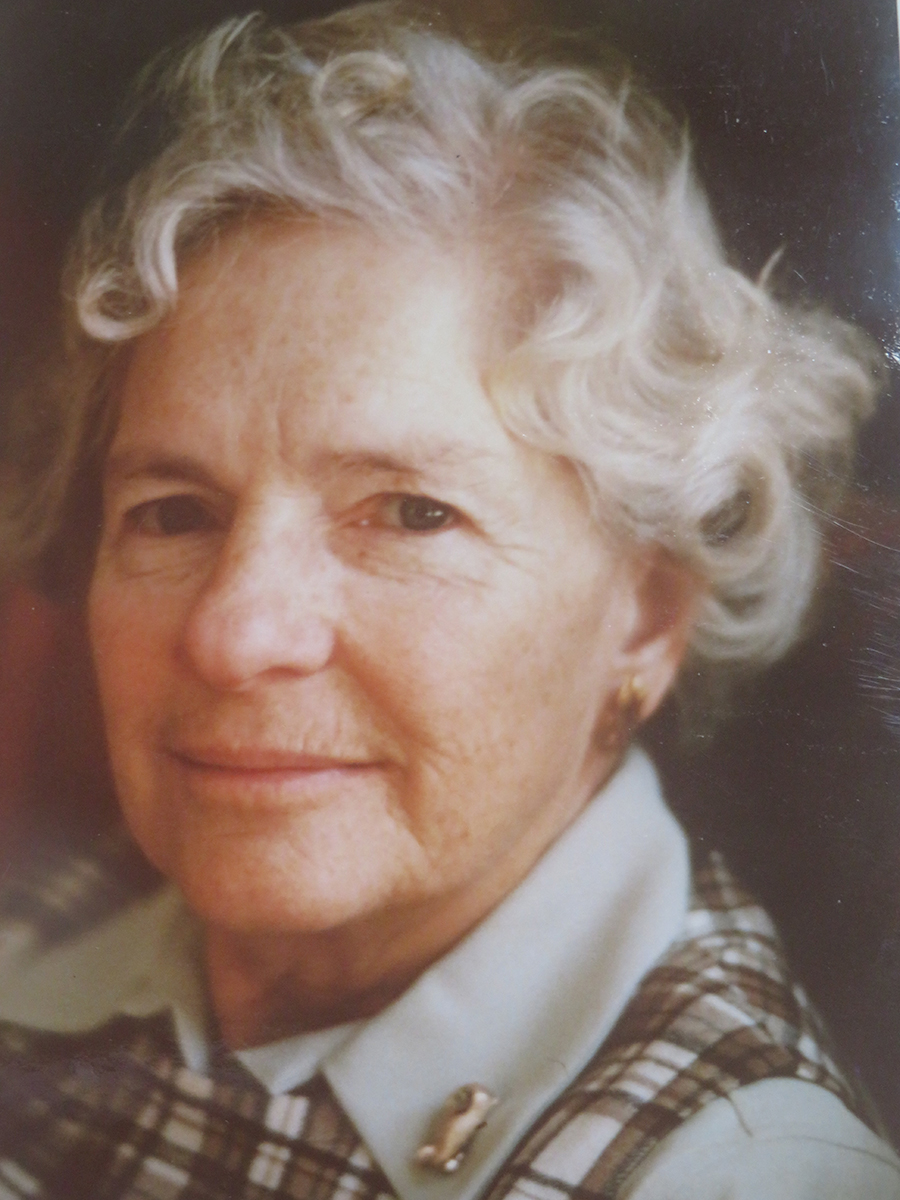
Sometimes when I can’t sleep and my mind’s all stirred up, I lie in bed and calm myself by making up an alphabetical list: towns in my state, for instance, the names of books, or favorite foods.
Just the other night, I got going on Thanksgiving. An ample subject! Easy, and I come right up with more than one choice per letter. Take C: cranberries? An obvious choice. No, wait, chop! Or cut—oh, yes, I sure do plenty of both cutting and chopping to prepare a Thanksgiving dinner, no matter how easy I swear I’ll make the job this year. And then there’s C for canned cranberry sauce, the jellied stuff I serve that others love. Nope, not that. I make my own Cranberry Compote. And Cranberry Bread, and Cranberry Torte. Oh, and coming soon, C for Christmas.
Finally, though, I decide: C is for chopping bowl. Not just any chopping bowl, though, but the old wooden one which came to me from Mom; that is, my mother-in-law, Lois Buffington It’s clearly the best choice, especially for its old blush of color in the “bowl” of the bowl.

Ten inches wide and no longer quite circular, the bowl’s warped from use. Stamped across the bottom is M U N I S I N G, which tells me it was made in Michigan by Munising Wood Products sometime between 1911 and 1955. I have no idea when Mom acquired this (by now) antique nor the mezza luna chopper we use with it, named in Italian for the roughly “half moon” shape of the blade. Though it is called (and often used as) a rocker knife for its back-and-forth motion, I always chop vertically with this tool. But I hardly prepare the entire Thanksgiving dinner with it, only the cranberries. For the rest, I work on a large cutting board with my favorite knives.
This wooden bowl also stands for T: tradition, or if you prefer, H for heritage. Someone before me used it in her kitchen. And there’s an intimacy about the bowl; that is, it holds only so much, and paradoxically, its open shape confines me. Too much zeal and the berries bounce out all over the counter—so I don’t lift the chopper high and lower the mezza luna like a guillotine! I must control my energy. But there’s a reward, a product, if I slow down.
As I work, the metal blade transmits its impact so my palm feels the wood of the bowl, its thickness and density, even as I’m holding another, harder piece of wood. I feel each chop, feel the cranberry skins part as I punch down. Skins broached, I then feel the berry flesh give way, and finally the blade’s chop-stop when it meets the bottom. Altogether, I am given a visceral, tangible degree of connection to the food I’m working with.
Ironically, my mother-in-law was a practical, “let’s get the job done” sort of person who probably wouldn’t have taken so much time to analyze this. A busy mother of three boys and in the summers, house manager of a big Cape Cod cottage, Mom had “a lot on her hands.” She’d be happy I’m using the chopping bowl, though, and it pleasantly reminds me of several other things and methods of hers that have come down to me. She introduced me to The Joy of Cooking as a basic resource; I own all her copies plus all the editions since my first one from 1963. Another cookbook Mom gave me, The Night Before Cookbook, has influenced me for decades now, even though I no longer use its actual recipes; over and over I’ve operated with that strategy, as she also did.
As well as the bowl, I own two pairs of Mom’s pewter candlesticks, some of her silver, her old wooden file box of recipe cards, and a beautiful blue/and/white Spode tea pot; this last, oddly, from a woman who didn’t care much for tea herself.
U is for using. And using her stuff now is certainly easier than I found getting along with her. If you’ve read my memoir A Place Like This, you can be pardoned for thinking it’s silently titled Getting Along With a Mom Like This. Over two decades after her death, I’m still reckoning with Mom, still chopping through my memories and learning from and about her. She and I were both strong women, something I didn’t realize— especially when I worked with her in the cottage—nor how much of an unspoken threat I might have represented. In those intense brief periods together known as visits, always on the other’s turf on opposite sides of the country, sharing common ground was tough. Now, rather than mother- and daughter-in-law, I like thinking of us as “kitchen sisters once removed.”
I sometimes wonder, How did it all come out, actually? I bet she sometimes had the same thought: when the guests have gone, the next night, finally you can taste the food you worked so hard to prepare.
Mom and I produced meal after meal for our families and friends, cut and chopped onions for stuffing or mashed potatoes or set tables and installed fresh candles in those candleholders. All the cutting and slicing and finger work, all the menu decisions, the grocery shopping, and figuring oven times; all the measuring, stirring, ladling, and serving. All the operations that make food and family dinners possible, the ground of Thanksgiving.
And here, unexpectedly, I’ve just remembered yet another instance of U is for using: Mom was the source of that alphabetical list sleep trick! Though she often listed the states and/or the presidents, in order! That list trick works.
Yet another way you furnished me with B for blessings—I am thankful to you, Mom, and for you.


LOVED this column! Keep on trucking! Tina
Thank you, Tina! Oh, I am keeping on! Be watching for it all! And thanks for your ongoing interest– I so appreciate it. Sally
The “C” that leads to Culinary Care on Christmas.
Maybe you will get to taste a sample of this – S is for sample, sez Sally. . . I’d better stop pretty soon! Thank you, Sharon —- Sally
Oh Sally! How I love reading your stories! I always find something relatable in my own life with them!
Thank you!
Irene, I’d love to know what struck a chord with you on this one! So glad it did, too —- Sally
“Altogether, I am given a visceral, tangible degree of connection to the food I’m working with.”
Sally, I think this explains why we all enjoy gathering around your table. You pass along that feeling of connection. Thank you!
Helen, Now you have to visit and see what I’m serving , right? I so hope for a reunion before too long. . . Sally
“Blush of color in the bowl of the bowl”….. oh yes! What a lovely description. And I, of course, went to your photograph to make sure I could see the bowl of the bowl blushing. (it was) You have written an ode to those of us who cook that damn meal that turns out to be everything to everyone regardless of the controversies! Thanks for your take on it! Very lovely. And thank you Lois, too.
You and I have shared many meals, too! — and often talked over the effort to please everyone, somehow. We could compose a menu of such meals – dinners at Mom’s table, right? You know the drill as well as I do! Glad you enjoyed this one — Sally
Love this one. I always get special joy when I use a pan my Grandma gave me, which was a wedding present she received back in the early 1900’s. It’s the perfect size for B is for … (brownies).
Someone sent me an email the other day saying that dishes should be done by hand, as it’s the perfect meditation experience. I say forget meditating over dishes. I’ll meditate over cooking, as you have described so well. Let the hubbies do the dishes (most of them, most of the time, anyway).
Thank you, Janet – And since you’re local, soon I can serve you something made using this chopping bowl — which would be a pleasure! “Keep watching this space” — I’ll probably post a recipe or two to share soon for Christmas.
And thanks for your ongoing interest! Sally
I needed a dose of beautiful, hopeful writing!
Ann, Thank you– and I wish I could serve you, too — dinner, or a lovely hot tea some winter afternoon. I so appreciate all your help and support! Sally